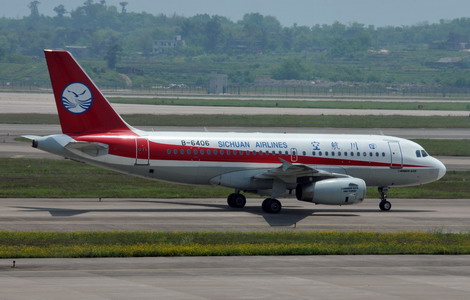International carriers targeting smaller cities
Updated: 2011-08-26 10:09
By Wang Wen (China Daily)
|
|||||||||||
A Sichuan Airlines Co Ltd passenger aircraft at Chongqing Jiangbei International Airport. The southwestern Chinese company has been approached by international carriers to discuss possible cooperation opportunities. [Photo / China Daily]
Second- and third-tier locations forecast for fastest air travel growth

BEIJING - China's second-tier cities are attracting attention from international airlines as they seek faster growth in the world's largest market for air travel.
International Airlines Group (IAG), Europe's third-largest airline group by market capitalization, has started a search to pinpoint possible destinations in southwestern China.
"We recognize that China is not just metropolises such as Beijing and Shanghai, and that other cities are also developing," Willie Walsh, chief executive officer of IAG, said on Wednesday.
Walsh visited Chengdu in Sichuan province on Thursday to talk with two local carriers, Chengdu Airlines Co Ltd and Sichuan Airlines Co Ltd, about possible opportunities for cooperation.
However, no details of the discussions have been released and Walsh said he will investigate more Chinese cities during the next two or three years.
"Chengdu will not be the only city we are interested in," Walsh said.
He said the group has a list of 10 potential Chinese cities and has complied a horde of related data for analysis of Chinese destinations popular with its customers.
On Jan 24, London-based British Airways PLC (BA) and Madrid-based Iberia Airlines SA announced an $8.5 billion merger, which created Europe's third-largest airline group by market capitalization. The airlines are already partly integrated, but their business in China is still operated by BA.
IAG currently operates 27 weekly flights from London to three Chinese cities - Beijing, Shanghai and Hong Kong. The number will be expanded to 30 this year, Walsh said.
IAG is not the only foreign airline eyeing second-tier Chinese cities.
Deutsche Lufthansa AG, the largest airline in Europe by market capitalization, has been providing a service between Nanjing in Jiangsu province and Frankfurt, Germany, since 2008. The airline also will launch the first intercontinental air route to Qingdao in Shandong province in 2012.
In March, KLM Royal Dutch Airlines, which belongs to the Air France-KLM Group, launched a service to Xiamen in Fujian province, its seventh destination in China.
"We are working on expanding our flight network to second-tier cities in China now," Marwan Koleilat, East Asia and South West Pacific senior vice-president of Qatar Airways Co, told China Business News late last year.
The rapidly rising demand for air travel in second-tier cities is prompting the attention from foreign carriers.
Statistics from the International Air Transport Association show that the global air passenger volume will increase by 800 million "person trips" in 2014, compared with 2.5 billion in 2009. Of that rise, 214 million will be related to China.
The global hotel investment services company Jones Lang LaSalle Hotels calculates that during the coning two years, China's second- and third-tier cities will see rapid growth in the availability of high-quality office space which could lead to an influx of business travelers. Chengdu is leading the growth in office accommodation.
"The number of international passengers passing through airports in second-tier cities is large enough to make daily international flights economically viable," said a staff member of the China Civil Airport Association (CAAC), who asked not to be identified.
The large volume of travelers at airports in big cities is also forcing foreign airlines to use facilities in second-tier cities.
According to the CAAC, there were 74 million person trips at Beijing Capital International Airport in 2010, making it the world's no 2 in terms of passenger throughput.
The airport also said that it handles an average 1,400 aircraft daily during peak traveling times.
"Airports in large cities are too busy to launch new routes," Walsh said. He added that IAG's ongoing recovery from the 2008 finance crisis means it now has the capability to develop in China.
The group reported operating profit of 39 million euros ($56.33 million) for the first half of 2011, after a loss of 419 million euros in the same period a year before on a pro-rata basis.
Walsh said IAG also expects to develop relationships with local carriers to provide a number of activities beyond just direct flights, but he gave no further details.
"Cross-shareholding is also possible," said a business insider, who is familiar with IAG.
IAG is also cooperating with local aircraft manufacturers and in 2010 signed an agreement with Commercial Aircraft Corp of China Ltd to provide help with customer services for the C919, the country's first large passenger aircraft.
"Maybe we will also use the C919 in our fleet in the future," Walsh said.
Related Stories
Just the ticket for travelers? 2011-08-24 11:28
Chinese airlines hike fuel surcharge to record high 2011-08-02 15:26
Airlines to fend off fast-train threat 2011-07-07 07:31
China's civil aviation reports profit surge 2011-01-12 10:00
- China Unicom Q2 profit outstrips analyst estimates
- Jobs' quit will provide more opportunities for ZTE
- CNR Corp posts 145% jump in H1 net profit
- China raises funding to boost grain security
- China's rail firms post shrinking profits
- ICBC stays on overseas expansion track
- Tough to meet CPI target, NDRC head says
- Control property policies to continue













